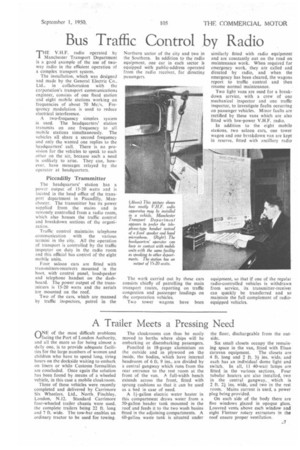Bus Traffic Control by Radio
Page 43

If you've noticed an error in this article please click here to report it so we can fix it.
THE V.H.F. radio operated by Manchester Transport Department is a good example of the use of twoway radio in the efficient operation of a complex transport system.
The installation, which was designed and made by the General Electric Co.. Ltd.. in collaboration with the corporation's transport communications engineer, consists of one fixed station and eight mobile stations working on frequencies of about 70 Wis. Frequency modulation is used to reduce electrical interference.
A two-frequency simplex system is used. The headquarters' station transmits on one frequency to all mobile stations simultaneously. The vehicles all share a second frequency and only the wanted one replies to the headquarters' call. There is no provision for the vehicles to speak to each other on the air, because such a need is unlikely to arise. They can, however. have messages relayed by the operator at headquarters.
Piccadilly Transmitter
The headquarters' station has a power output of 15-20 watts and is located in the head office of the transport department in Piccadilly, Manchester. The transmitter has its power supplied from the mains and is remotely controlled from a radio room, which also houses the traffic control and breakdown sections of the organization.
Traffic control maintains telephone communication with the various termini in the city. All the operation of transport is controlled by the traffic inspector on duty in the radio room and this official has control of the eight mobile units.
Four saloon cars are fitted with transmitters-receivers mounted in the hoot, with control panel, loudspeaker and telephone handset on the dashboard. The power output of the transmitters is 15-20 watts and the aerials are mounted on the roof.
Two of the cars, which are manned by traffic inspectors, patrol in the Northern sector of the city and two in the Southern. In addition to the radio equipment, one car in each sector is equipped with public-address operated from the radio receiver, for directing passengers.
The work carried out by these cars consists chiefly of patrolling the main transport routes, reporting on traffic congestion and passenger loadings on the corporation vehicles.
Two tower wagons have been similarly fitted with radio equipment and are constantly out on the road on maintenance work. When required for emergency work, they are called and directed by radio, and when the emergency has been cleared, the wagons report to traffic control and then resume normal maintenance.
Two light vans are used for a breakdown service, with a crew of one mechanical inspector and one traffic inspector, to investigate faults occurring on passenger vehicles. Minor faults are rectified by these vans which are also fitted with low-power V.H.F. radio.
In addition to the eight mobile stations, two saloon cars, one tower wagon and one breakdown van are kept in reserve, fitted with ancillary radio equipment, so that if one of the regulat radio-controlled vehicles is withdrawn from service, its transmitter-receivet can quickly be transferred and so maintain the full complement of radioequipped vehicles.
















































































